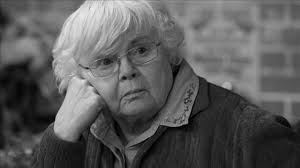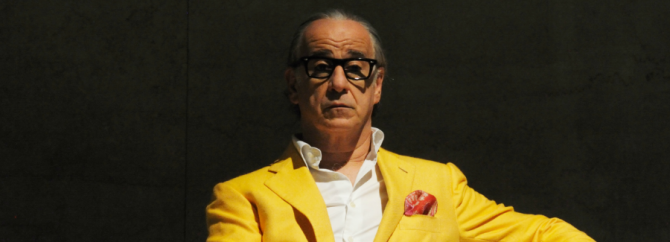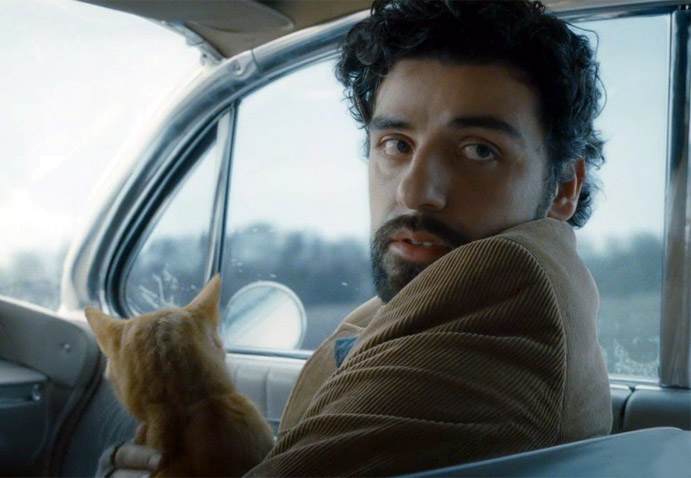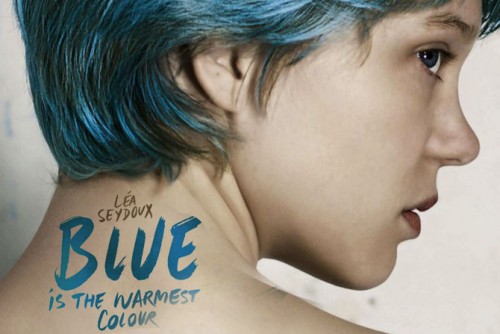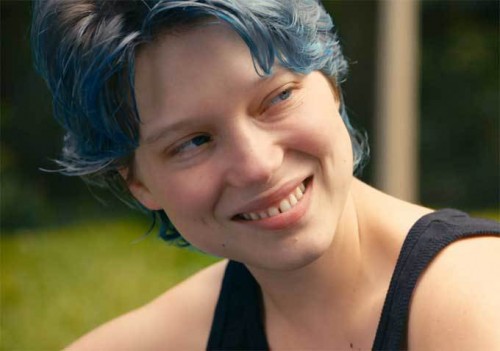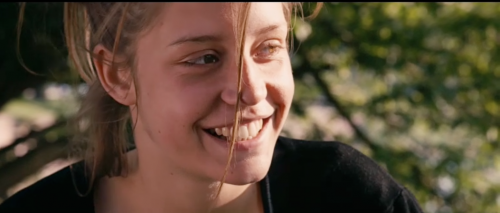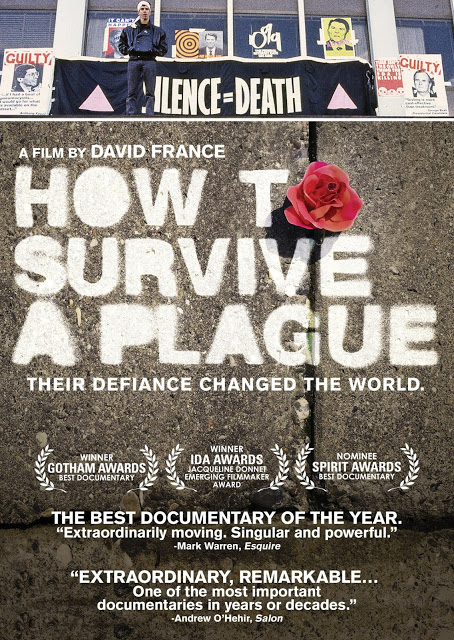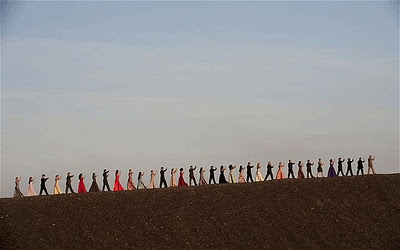“Mind if I get naked,” the main character of Stranger By The Lake asks a fat, older shirtless man in the middle of a conversation. The two characters are at a nude men’s beach, so the question isn’t unexpected, but in a film which isn’t porn (and this film is not porn), male actors are rarely asked to be nude, and when they are, we most often see their backsides only. In non-porn films actresses are usually the ones with their clothes off, a situation that echoes the famous poster from the Guerrilla Girls which asks if women have to be naked to get into the Metropolitan Museum of Art. Women are still a tiny minority of film directors but naked women in films are plentiful, the stills forever appearing on websites where commenters can criticize every aspect, no matter how trivial, of the actresses’ bodies and debate whether the women are “hot or not.”
Stranger By The Lake (directed by Alain Guiraudie) won accolades (Best Director and The Queer Palm Award) alongside Blue Is The Warmest Color at Cannes, but is only now being released in the US, in what is generally considered to be the worst month of the year for a film to open. Movie distributors seem not to realize that an explicit film about male cruising (and this film has more penises in it than most porn films do), especially one as well-reviewed as Stranger, has the potential to attract an audience beyond just gay men: many women, straight and queer, are curious about the type of anonymous, repercussion-free sex shown in the film–because it’s not available to us (in spite of one man in the film who insists women sometimes come to the cruising site). We wonder about the option of sex being just another stop on the way home, after getting milk and bread at the supermarket and picking up the dry cleaning.

This phenomenon of women being interested in sexual encounters between men is also nothing new: yaoi comics in Japan depict often explicit relationships between men and its audience, as well as its writers, have always been mainly women. In other countries, explicit slash fan fiction is almost exclusively written by women, including queer women, and most of the sex is between men. Although some claim this focus on male sexuality is a form of misogyny, the rationale might be more complex.
Women in porn and other sexually explicit video and film are regularly degraded both on camera and off (see the controversy around Blue Is The Warmest Color). In a culture that seems to place so little value on a woman’s sexual pleasure and autonomy (if we take the films of our culture to be its mirror) we shouldn’t be surprised that women of all sexual orientations would look to gay men’s porn and sexually explicit material about men to see onscreen sexual interplay that doesn’t degrade women. The two films I can think of in which women are allowed to have explicit sex (which coincidentally seems to not be simulated) with men and are not somehow punished or denigrated for it were directed by gay men: the late Patrice Chereau’s Intimacy (in which award-winning actress Kerry Fox takes a penis into her mouth on camera) and John Cameron Mitchell’s Shortbus, in which Sook-Yin Lee’s character sexually experiments: one scene has her straddling the penis of a reluctant husband.
Straight men are the only audience who might be squeamish about seeing a film which centers around anonymous sex between men, features copious amounts of full-frontal male nudity and even has a couple of scenes in which the sex is obviously unsimulated (these scenes are cut into the action and so do not involve the actors we see). But marketers are pretending all the rest of us would react to this film like a thirteen-year-old boy who wishes to convince the world he’s straight: “Eww, penises.”

The script (written by director Guiraudie) is pared down to its essentials. The action takes place completely on a men’s nude beach by a lake and the cruising spot in the woods right next to it. We don’t find out the name of the main character, Franck (Pierre de Ladonchamps) until he introduces himself to the man who fascinates him, Christophe Paou’s Michel (as opposed to the fat man we never see naked but whom Franck enjoys talking to: Henri). Franck and Michel exchange names after the first time they have sex, just one day after Franck has witnessed Michel intentionally drown a fellow beachgoer.
I was fortunate to see a screening with the director present. In the question and answer period after the screening, I asked why the sex scenes, even though they contained some of the same material as porn, didn’t remind me of porn. The director speculated that we are not used to seeing scenes with “waggling organs” (he spoke in French but had someone translating by his side) that move the story along–as the sex scenes in this film do. He also mentioned that because the explicit scenes were cut into the other action, the scenes didn’t need to drag and play out over real time the way they do in porn clips.
The director said that Franck “falls in love” with Michel before the murder. We can construe the whole film as a metaphor for romantic love itself, much like in Michael Winterbottom’s first film Butterfly Kiss in which timid, sensitive Miriam (nickname: Me) runs away with murderous Eunice (nickname: Eu) and Me does her best to convince Eu that the trail of bodies (like so much we learn about our romantic partners) Eu leaves in her wake doesn’t bother her.
“Falling in love” isn’t something we expect to happen in a cruising spot, but the director used the phrase repeatedly, reminding me of author Edmund White‘s description of 70s cruising and anonymous sex as something that involved the heart, not just the genitals. The men at the beach do have a camaraderie together. Franck hugs and kisses a regular beachgoer with grey hair (played by the director) and sometimes makes plans to meet with him at the club–though he doesn’t go into the woods with him. Franck and Henri have dinner together (offscreen) more than once. The bond among the men extends even to the ever-present masturbating voyeur, to whom one man shouts, “We’re talking now. We’ll be fucking later. Come back then.” But the murder victim’s car is conspicuous in the tiny parking area. His towel remains laid out, empty, on the small beach like a grave, and no one remarks about it. The camaraderie goes only so far.

Franck eschews condoms in his encounters with men (not just Michel) in the woods, absurdly saying to one with whom he has barely exchanged five words, “I trust you.” The chance Franck takes in pursuing Michel is similar. Soon after the drowning, the two men swim together, alone at night, an almost identical scenario to the one in which Michel (who with his mustache and dimples resembles a young Tom Selleck) drowned the other man. Franck is hesitant, but gets into the water with Michel anyway.
The conflation of sex and death is also clear in a scene in which we see a man crying out and moving under another man in the tall grass near the woods. We are unsure: are they having sex? Or is one man killing the other? The movie points out the twisted logic of most film content and ratings: we are much more likely to see in a (non-porn) film a fatal wound gushing blood than we are to see a penis ejaculating.
After the drowned man’s body is found, a police detective questions the men at the cruising spot, a strategy that doesn’t seem like it would yield much success: even before the murder the beach and woods are places for them to keep secrets. Most of the men don’t know each other’s names. Henri had, until recently, a longtime girlfriend who doesn’t seem to have known that he also had sex with men. We find out the voyeur has a jealous husband who one day accompanies him to the beach. Besides lying about the murder, Franck tells the detective, “I don’t come here often,” when we see that he’s there every day.
Because queer characters in film were vilfied for so long, movies with murderous, violent or manipulative queers in them can give off the stink of homophobia: The Talented Mr. Ripley and Notes on a Scandal are two examples of films which angered me. Guiraudie, like other queer directors handling similar material, (see Todd Hayne’s Poison) seems to avoid this problem perhaps simply because the murderer is just one of many queer characters in the film.
Queerness, like nudity in Stranger is the norm: those who are straight and keep their clothes on are the outliers. The effect of seeing so many penises, presented so matter-of-factly in a film is like being at a nude beach ourselves: the naked flesh isn’t remarkable, so we don’t gawk. This ubiquity and also perhaps the knowledge early on that Michel is a murderer (and we don’t find out much more about him beyond his attractive, smiling surface) kept me from finding the film erotic, in spite of its explicit content. But it is a compelling portrait of characters reaching out for connection, trying to overcome their loneliness, afraid of the void. When, at the end, Franck cries out into the dark, he could be any of us.
[youtube_sc url=”http://www.youtube.com/watch?v=PgcEGKn7waI” autohide=”0″]
___________________________________________________
Ren Jender is a queer writer-performer/producer putting a film together. Her writing has appeared in The Toast, xoJane and the Feminist Wire. You can follow her on Twitter @renjender.










